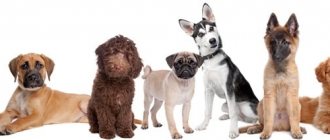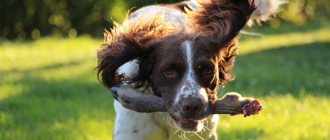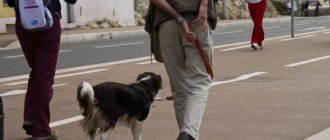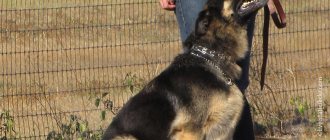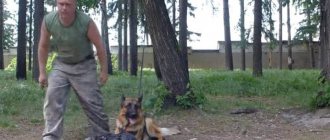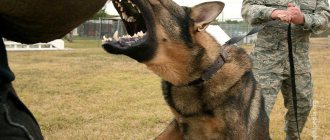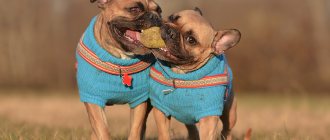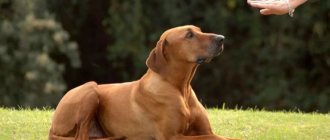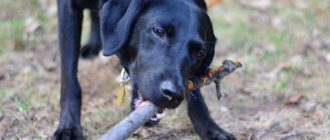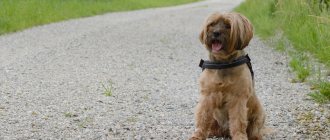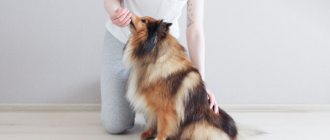The program of basic obedience courses for dogs must include the “Stop” command.
It is taught strictly after the orders “Sit” and “Lie Down” .
This order is explained by a more inconvenient method of coercion. Instead of pressing on the sacrum, the trainer has to apply pressure on the stomach so that the four-legged animal rises and takes the desired position.
The effectiveness of the final result depends on compliance with standards and regulations. Therefore, first of all, it is necessary to familiarize yourself with the theory and sort out common mistakes.
Who is this article written for?
This material will help: - dog lovers who are just getting ready to take the first steps with their pet in the show ring, but do not yet know how to independently prepare the dog for the show; - owners who do not have the opportunity to pay professional handlers for training sessions and for showing their dog or, due to their territorial remoteness, do not have the opportunity to use their services.
A few numbers. Today, the cost of one hour-long group lesson on preparing a dog for an exhibition starts from 500 rubles per dog. An individual lesson, of course, will cost even more. Also, the cost of exhibiting a dog by a handler in the ring starts from 1000 rubles per ring, and this is the price for an “on-site” exhibition. A traveling exhibition (with a trip to another city) will cost you much more.
When to contact a dog trainer or take a course
On average, the first noticeable results are achieved after 2 weeks, subject to daily exercise for 15 minutes. If they are absent, you should consult with a dog trainer or enroll your pet in dog training courses. Completing UGS and OKD is also recommended for the purpose of developing obedience - and as preparation for more complex courses like ZKS.
In most cases, prolonged lack of results is explained by mistakes made during the training process. If you want to work on them, then it makes sense to take individual lessons together with a dog handler.
Our history. How it all began.
Chucky was my first dog, and then I had very little idea of all the intricacies of holding exhibitions, so when the exhibition career of my 12-time Champion ( Jack Russell terrier Chucky Black ) was just beginning, I decided to trust the professionals. I took the puppy to classes at a handler's gym (fortunately, there is one in Belgorod), to a good, trusted specialist - the handler was recommended to us by the breeder from whom we bought our Chucky.
Of course, then I didn’t even think about exhibiting it myself. At the very first exhibitions, Chucky entered the Bests, received the best descriptions from experts, the highest ratings and wishes to definitely pursue his career!
From the dizzying success, we “fell ill” with exhibitions!.. There were traveling exhibitions ahead in Tula and the largest Russian special breed exhibition “Russell Show” in Moscow , but our beloved handler was going on maternity leave... I realized that then I would have to learn to get out on my own!
Sobakevich was smart and immediately understood what was required of him, but I was very worried about my inexperience in the ring. We started going to classes at the handlers' hall, mostly to prepare me for shows.
I still remember how nervous I was in the ring in Tula... I am immensely grateful to Lyudmila Vasilievna Anishchenko (international category expert, head of the Credo kennel club in the city of Tula) for the wonderful warm atmosphere at the exhibition. Newcomers, like me, received tremendous emotional support from her! I remember a couple of times she even went into the ring with the dog herself to show us a mini master class on how to properly expose the dog.
It was then that I saw and analyzed for myself that dog owners who do not bother with the services of professional handlers and ignore the need for show training exist, and, moreover, even go to exhibitions! True, the show stance of their dogs in the ring reminds me more of the crucifix in the picture below...
Dog show stand - what is it for?
The main goal of visiting an exhibition is to get an expert description and assessment of the dog. The expert must carefully examine the dog, analyze its breed qualities and describe how accurately they correspond to the existing breed standard. For this purpose, the dog is always assessed in movement and in standing position.
We'll talk about movement in the ring next time, but now let's focus on the dog's exhibition stance. A show dog must be able to stand still and calm. While the dog is standing, the expert will look at it from the side and also touch it - he will evaluate the dog’s condition, the condition of the coat, the strength of the limbs, etc.
Chucky Black Belogorye at the international dog show in Poland (Sieradz).
July 2016. The examination is conducted by Jane Paradise (Great Britain). All dogs, without exception, must demonstrate the number of their teeth and their appearance, the condition of their gums and bite upon the command “Teeth”. Here, at the expert’s discretion, there are two options for the development of events - the expert can raise the dog’s lips independently or ask the handler to do it.
International Dog Show in Minsk (Belarus) - June 2016. Natalia Levitte (Germany) examines Chuckie Black's teeth.
The expert also mandatory manually assesses the condition of the testes in male dogs. The dog must be prepared for all possible manipulations of the expert and react to them completely calmly.
Keep in mind that during the examination of the dog, the expert evaluates not only the physiological, but also the psychological characteristics of the dog. Dogs that demonstrate cowardice or aggression in the ring will be disqualified and will not receive a breeding assessment. This means that in the future they will not be allowed to breed!
Which word to choose
First you need to decide on a voice order. If you do not plan to participate in exhibitions, then you are given complete freedom of choice.
"Stop", "Stand" or other variations
Remember that doing it right is much more important than the word you use. In addition to the classic “Stand,” you can choose something else to suit your taste: “Stand,” “Show,” “Stand,” “Stand.”
Much more attention should be paid to the releasing word. The worst option is “Come to me.” It involves moving towards the owner, so it will be very difficult for the animal to maintain the desired position for a long time. For this reason, dog handlers recommend approaching the dog on your own and letting it go with the word “Walk.”
Teams for exhibition career
If you plan to attend exhibitions, then, in addition to “Stand,” you will have to study many other important orders. The animal must calmly react to the word “Inspection” and the manipulations characteristic of it, as well as freely demonstrate the bite when hearing the word “Teeth” from the owner, and walk at a trot after pronouncing the word “Let’s go.”
What should a dog's show stance be like?
The beautiful exhibition stance of the future Champion should be free, natural and beautiful. This is exactly the stance a well-trained dog demonstrates.
Chucky Black in a free stance at the international dog show in Riga (Latvia).
April 2016 The dog that was trained knows perfectly well what and how it should do and how to behave correctly in the ring - it is confident and calm, stands motionless while the expert examines and touches it. Such a dog does not get scared and does not tuck its tail, does not grin or growl. Such a dog obviously has a better chance of winning the ring than one that is not prepared and, most likely, is under some stress or confusion from an unusual situation for it and therefore cannot show itself in all its glory.
Free stance of the dog
The concept of “free stance” means that the handler does not touch or correct the dog with his hands. The dog takes the correct position on its own, on command.
You need to think about what this command will be like in advance and start training the puppy, be sure to clearly and clearly pronounce this word. There is no standard command for this case; choose according to your taste - for example, it could be the word “Show” or “Stand”.
Communication between owner and pet
While you are practicing the skill, there is constant interaction between you and the dog. It is very important that the dog trusts the person as its owner. In order to achieve the required level of communication, you need to try to find a suitable approach to education from a young age of the dog. Yes, and teaching a dog to stand becomes much easier when you think about how to build communication. The interaction between the animal and the dog affects the rate of formation of the reflex and the level of the animal’s opening to new experiences. But do not forget about the pet’s personal characteristics and type of temperament. Learning a motionless, static exercise can be quite difficult.
Therefore, when communicating during training, dog handlers recommend being based on the following principles:
- Be patient;
- Plan the exercise by developing an algorithm for studying it;
- Use encouragement and praise;
- If the dog fails to follow the command, do not scold it. Correct the mistake and praise.
Planning is very important in learning. Teaching dogs commands becomes easier if you have a clear picture of the end result. Then all you have to do is subordinate any action to achieving the goal.
When should you start preparing your dog for shows?
The correct stance, in my opinion, is the most difficult of all the necessary skills for a dog to participate in exhibitions, so training a dog must begin from puppyhood.
Short but regular classes can already be started from the moment the puppy moves from the breeder to the owners.
If experts are always ready to make allowances for inexperience for puppies in the “Baby” age group, then starting from juniors, and even more so in the class of young dogs, a show dog should already demonstrate a well-practised stance.
Socialization of the dog, beautiful productive movements in the ring, as well as show grooming are also very important, but these are separate topics for discussion.
How to teach a puppy to stand.
The first thing you need to start with is to completely capture the puppy’s attention. The easiest way to do this is with food or treats, so you need to train your dog on an empty stomach. Let the puppy sniff the food, lead him by your hand, luring him with a treat. Praise, sometimes give a “piece” to maintain motivation. If the puppy is not distracted and follows your hand like a magnet, you have mastered the first exercise.
Remember that the younger the puppy, the shorter your sessions should be. Start with a couple of minutes a day, gradually increasing the time. The main thing is to exercise regularly and do it positively. Your contact with your dog should be pleasant - always reinforce the dog's correct behavior with praise and treats.
The dog should “love” such activities, since they are not tiring and are accompanied by treats.
A few words about the delicacy. It should not be dry (the dog can easily choke) and should not crumble (so that the pieces do not fall to the ground and distract the dog from its activities). The pieces themselves should be small in size, otherwise the dog will quickly get full and lose interest. The person should take several pieces of treat into his fist at once and give them to the dog one at a time, as if counting out coins with his thumb. It is convenient to use as such “goodies”, for example, low-fat boiled sausage, sausages, boiled beef heart or pieces of beef or turkey scalded with boiling water.
Once the bite-magnet exercise has been mastered, you need to teach the puppy to freeze in a balanced position. Now you give food only when all four paws are firmly touching the floor. Dogs are very smart creatures, the puppy will “figure out” at what moment he receives his treat and will remember why he was rewarded by you. Your task is to give a piece only at the moment of correct completion of the task!
Gabi Black - Best Baby of Show in Tula.
July 2016 Be patient and kindly persistent, remember that a puppy is a small, restless child who is bored without play and movement. If the puppy has learned to freeze for a few seconds without jumping up or trying to bite the food out of your hand, then you can try putting the puppy in a show rack.
In my opinion, the simplest and most reliable way to practice a show stance with a dog is to use a special simulator called “Happy Legs” - “ Happy Paws ” or, as it is called in the “canine common people” - “ happy ”.
Which motivation (method) to choose?
Applying the same method to absolutely everyone is irrational, since four-legged pets are very different from each other. The most commonly used methods of influence are:
- Treating.
Effective for food dogs. They are motivated by various treats and regular food.
- Toy guidance.
If your pet reacts to the game with much more enthusiasm, then this is a typical gamer. The principle of training here is exactly the same as in the first case, but instead of food, a toy is given as a reward.
- Pushing.
Involves indirect physical impact. The owner places the pet in the desired position by pulling the leash or pulling it by the collar.
- Passive inflection.
It is built on trust between owner and pet. In this case, the initiative rests entirely with the person. He corrects all actions and the final position of the dog by direct influence.
You can use either 1 method or several at once. If none of them brings the desired result, seek help.
What are Happy Legs?
A dog stance training machine can be purchased on the Internet. Although, having the necessary materials, happy leggings are quite easy to make yourself.
Today there are many designs of happy pads, but the essence of all is the same - these are four non-slippery elevations for the dog’s paws, which allow you to reliably hold it in a static position.
Each paw support has a limited area, so the dog will not be able to step from paw to paw, mark time, jump, much less sit down. The dog turns out to be “fixed” in a position where its front and rear, as well as right and left paws are located clearly parallel to each other - on the same line.
Various Happy Legs Designs
If you have several dogs of different sizes or a puppy (who, of course, continues to grow), then an adjustable stand trainer is your option. For example, this: Option 1.
Thanks to the adjustable support positions in length and width, these happy leggings are very comfortable and can be easily adjusted to suit dogs of different sizes:
Option 2. Another model of an adjustable happy pet, built from bars on stiletto heels, which can “grow” with your pet.
Or “within”:
Option 4.
In handling halls they often use the simplest version of Happy Legs - two “bedside tables”.
During training on such a simulator, you will have to be more careful to ensure that the dog in the stance places its paws correctly - not too close, but not too wide.
In addition, each time you will need to “adjust” the happypick again in accordance with the “length” of your dog.
It’s great if you have the opportunity to show your dog on such happy leggings in front of the mirror. This will help you evaluate from the outside the parallelism of the paws.
Practicing the “Stand” command: standards and rules
It is recommended to start training immediately after mastering the skills of “Sit” and “Lie down”. Don't delay this if you plan to take part in the junior section at a dog show.
According to the standards, the pet must stand in a stance for 2-3 minutes or 15 seconds when the owner is 15 m away. Having achieved perfect execution at home, feel free to go outside and include more complex elements in the form of a gesture.
Voice command
Practice in any appropriate situation: while washing your paws, while swimming, before a pedestrian crossing or entering a shopping center. Make small exposures of a couple of minutes and practice retreating in different directions by the length of the leash. Such activities form adequate behavior that prevents a state of panic when tied in front of a supermarket.
Be sure to stop any attempts to leave the place before saying “Walk”. Complicate the demonstration of the skill by alternating with “Sit” and “Lie down”. According to the standards, in the first case the dog must rise, taking a step back with its hind legs, and in the second, straightening all 4 legs at once.
Gesture
For an already trained dog, the command “Stay” is complicated with a gesture. During the lesson, the owner should be directly in front of the pet, at a distance of one step.
At first, the gesture is performed simultaneously with a voice order: the lowered right hand is raised with the palm inward, bending at the elbow. When the desired reaction is obtained, the animal is given a treat.
NOTE!
The gestures for "Stand" and "Down" are very similar. In both cases, an open palm is used, but in the first case, the inner side rises upward, and in the second, downward.
Before putting the dog in a Happy Stance
Let's talk about safety precautions - once again I will draw your attention to the fact that the surface on which the dog places its paws should not be slippery. Otherwise, the situation will turn out like in the photo below - the paws will slip, and the dog will definitely begin to get nervous because of its unstable position.
The same should be noted about the surface on which the happypick is installed. It must be level so that the simulator stands level and does not wobble, distracting and irritating the dog.
Never leave your dog alone on a happy hour, be nearby and insure your pet. You need to be especially careful when working with puppies so that if they stumble, they do not fall. Therefore, it is best to work with the “baby” on the floor and not on the table.
Properly executed stance
When judging takes place in the ring, much attention is paid to the dogs' ability to remain composed and present themselves. This skill is necessary to perform the “stand”.
During the exercise, the pet must hold in a special position, which is assessed by an expert. He also pays attention to what the dog looks like, for example, its coat, teeth, muscles. Therefore, even checking with your hand should not distract your pet from the exercise. It is possible to teach dogs to stand, but to do this you need to be prepared to spend more than an hour of time explaining to your pet the essence of the exercise.
The stand can be performed either on the floor or on a table. It is better to train your pet on an elevated surface. This way you can limit the space allocated for the rack.
During training, make sure that the dog's front paws are directly under the shoulder blades. The hind legs maintain a wide angle, which is approximately 95-100 degrees. A beautiful stance can be attractive not only aesthetically, but also allows you to evaluate the body of the animal and its ability to be in a given position. This position must be stable and demonstrate to the assessor the dog's posture, leg strength and ability to hold the position. It is important to try to work on getting your pet to hold his head in profile or look at the person evaluating the exercise.
Tired, want to relax? Book a dog walk!
Find out more
submit your application
Functions of the simulator for training the stance in dogs.
The main tasks that happypic helps to solve:
- helps to reduce the time during which the dog masters the show position,
- helps the dog feel the correct balance of the body,
- allows the animal’s muscle memory to fix the correct paw placement,
- develops the dog's endurance, obedience and ability to concentrate,
- creates a positive attitude towards work in the dog through positive reinforcement.
How did we do the dog stand trainer?
Basic Rules:
- First, you need to practice with a hungry dog.
- Secondly, do not forget about the obligatory reward of the animal not only with a “piece”, but also with praise.
- Thirdly, exercise regularly and increase the duration of exercise gradually, without overtiring your dog.
I’ll tell you how I worked with my dogs. With a piece, I “lured” the dog to the happy peak in such a way that he himself placed his front paws on the posts. She gave her a treat, praised her, and on the command “At ease,” she let the dog go. And so on several times. This is the first stage - the dog gets used to the happy mood and a positive attitude is formed for training.
When the dog quickly and “fun” learns to stand with his front paws on the happy leggings, we help him “install” his hind paws on the posts. We take the leg by the joint and with a smooth movement. When all four paws are “in place”, we praise the dog, feed it and release it, but always only on command!
Speaking of teams. When you start training on the simulator, be sure to give a specific command. For example, " Stand " or " Ring" . Repeat it every time you start classes. In the future, when the dog hears this command in the ring, it will be a kind of “beacon” for its calmness and correct behavior.
Since I'm talking about teams, I'll continue. In order for the dog to be ready for a manual examination in the ring, you also need to prepare - train a special command with the dog, you can call it, for example, “ Inspection ”. Put the dog in a stand, and let someone from the family, or better yet a friend, touch and feel your dog - from the top of the head to the very tail.
Don't forget to practice the " Teeth " command. Start training yourself - lift the dog’s lips on one side, then on the other, and keep them open for a while. Then connect some “assistant” who can do this with you.
Don't forget to periodically praise, pat, scratch your dog for correct behavior and give him a treat.
Let's return to our simulator. When the dog calmly stands up on the happy peak, we lure it with a treat so that the dog’s body stretches out in a straight line - the muzzle and tail should be on the same “visual axis”. It is enough to hold the baby for a few seconds and immediately allow “Free”; we hold the adult dog longer - about 30 seconds.
Remember that the time needs to be increased gradually. After all, we will study regularly , and regularly, in my understanding, means at least once or twice a day. On the eve of the exhibition, for several days I feed the dog only on the happy feed.
So, our dog learned to stand on the happy pike, she remembered that it was good - she was fed deliciously there and praised. She loves to exercise! We begin to slowly but surely train endurance - increase the time the dog spends in a standing position.
To make it easier for me and more understandable for the dog, I came up with the idea of training the dog to count. I say “one, two, three, four, five” and give them a tasty treat. Pause and again - “one, two, etc.” , delicacy. And so on several times. The further (with each subsequent lesson), the slower I count, the longer I pause between words.

